Strategic Supply Chain Management and Converse's Challenges
VerifiedAdded on 2023/04/23
|20
|5234
|230
Report
AI Summary
This report analyzes Converse's strategic supply chain management, focusing on challenges like ineffective demand forecasting, cost and quality management, and delivery speed. It evaluates current strategies in lead time management, customer and supplier relationships, and cross-dock operations, identifying issues such as inaccurate forecasts and IT infrastructure gaps. The analysis is underpinned by relevant theories and literature, comparing current practices with proposed future strategies. The report recommends a lean approach over agile and suggests amendments to Converse's proposed supply chain model. It also covers the importance of big data, buyer-supplier relationships, just-in-time inventory, and e-supply chain management. The report concludes with recommendations to improve Converse's supply chain efficiency and maintain its competitive advantage.

Running head: STRATEGIC SUPPLY CHAIN MANAGEMENT
Strategic Supply Chain Management
[Converse]
Name of the student:
Name of the university:
Author note:
Strategic Supply Chain Management
[Converse]
Name of the student:
Name of the university:
Author note:
Paraphrase This Document
Need a fresh take? Get an instant paraphrase of this document with our AI Paraphraser

1
STRATEGIC SUPPLY CHAIN MANAGEMENT
Abstract
The main purpose of this report is to analyze the strategic supply chain management plans of
Converse and recommend a few points of suggestions to the company. The company as
mentioned in the presentation file currently faces a range of supply chain challenges. These are
ineffective demand forecast, ineffective cost and quality management of inventories and delivery
speed to market. These issues are real concerns for Converse considering that it is a part of
Nike’s business, which itself enjoys a globally popular supply chain. Hence, an ineffective
supply chain at Converse may also result in reputational damage to Nike. These issues are
problematic also because Converse might not be able to hold the competitive advantage it has
and nurtured for so many years being in operations. Hence, the strategic supply chain
management is being analyzed from relevant scholarly articles. These articles delivered a few
important tools and techniques as repairing options to the damages being done so far. The
findings of these articles are being compared with the current practices and the future supply
chain strategies at Converse. By conducting comparison as such the report does, it helps to
identify the best supply chain strategy to sort out its current issues. The paper recommends
‘Lean’ over ‘Agile’ and so recommends making a few amendments to the proposed supply chain
model at Converse.
STRATEGIC SUPPLY CHAIN MANAGEMENT
Abstract
The main purpose of this report is to analyze the strategic supply chain management plans of
Converse and recommend a few points of suggestions to the company. The company as
mentioned in the presentation file currently faces a range of supply chain challenges. These are
ineffective demand forecast, ineffective cost and quality management of inventories and delivery
speed to market. These issues are real concerns for Converse considering that it is a part of
Nike’s business, which itself enjoys a globally popular supply chain. Hence, an ineffective
supply chain at Converse may also result in reputational damage to Nike. These issues are
problematic also because Converse might not be able to hold the competitive advantage it has
and nurtured for so many years being in operations. Hence, the strategic supply chain
management is being analyzed from relevant scholarly articles. These articles delivered a few
important tools and techniques as repairing options to the damages being done so far. The
findings of these articles are being compared with the current practices and the future supply
chain strategies at Converse. By conducting comparison as such the report does, it helps to
identify the best supply chain strategy to sort out its current issues. The paper recommends
‘Lean’ over ‘Agile’ and so recommends making a few amendments to the proposed supply chain
model at Converse.
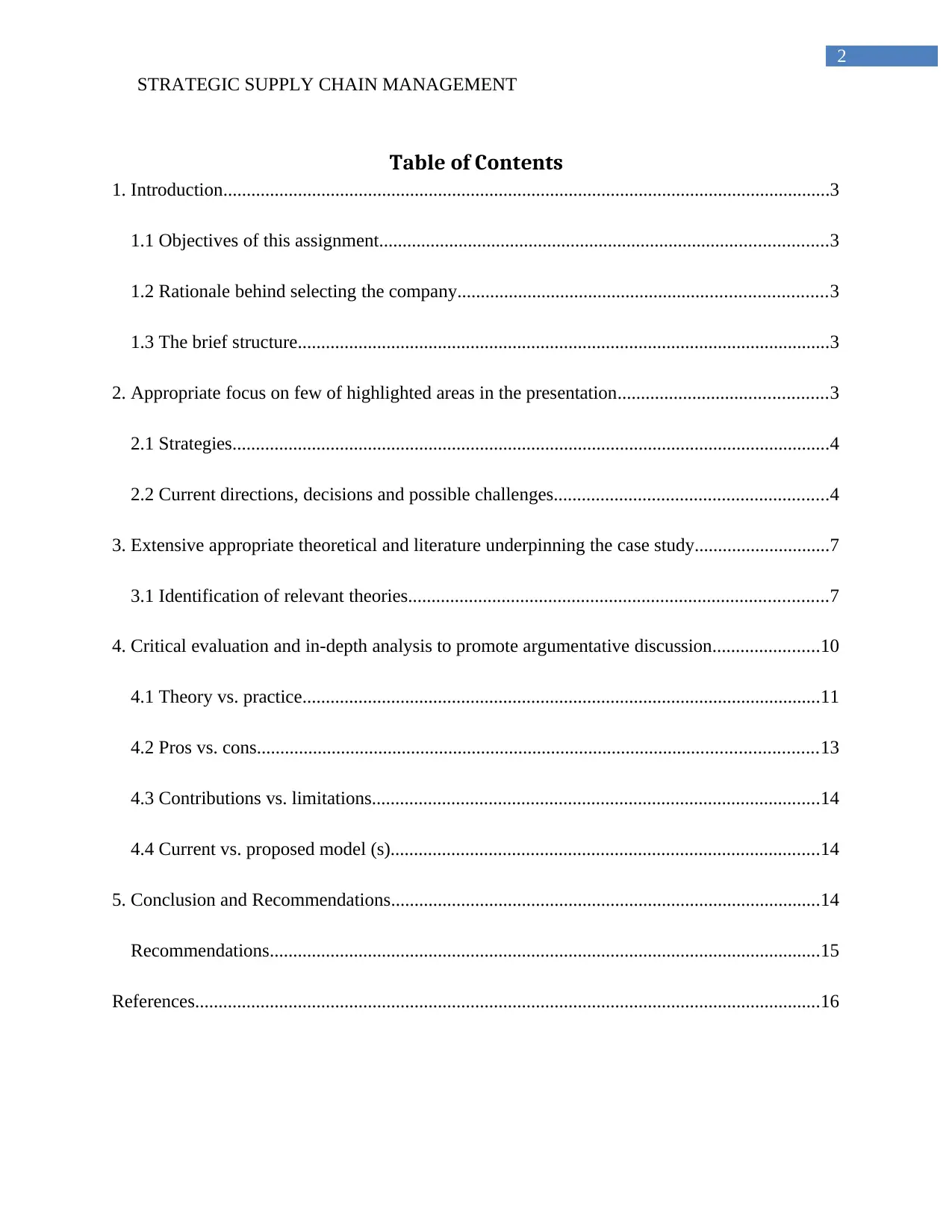
2
STRATEGIC SUPPLY CHAIN MANAGEMENT
Table of Contents
1. Introduction..................................................................................................................................3
1.1 Objectives of this assignment................................................................................................3
1.2 Rationale behind selecting the company...............................................................................3
1.3 The brief structure..................................................................................................................3
2. Appropriate focus on few of highlighted areas in the presentation.............................................3
2.1 Strategies................................................................................................................................4
2.2 Current directions, decisions and possible challenges...........................................................4
3. Extensive appropriate theoretical and literature underpinning the case study.............................7
3.1 Identification of relevant theories..........................................................................................7
4. Critical evaluation and in-depth analysis to promote argumentative discussion.......................10
4.1 Theory vs. practice...............................................................................................................11
4.2 Pros vs. cons........................................................................................................................13
4.3 Contributions vs. limitations................................................................................................14
4.4 Current vs. proposed model (s)............................................................................................14
5. Conclusion and Recommendations............................................................................................14
Recommendations......................................................................................................................15
References......................................................................................................................................16
STRATEGIC SUPPLY CHAIN MANAGEMENT
Table of Contents
1. Introduction..................................................................................................................................3
1.1 Objectives of this assignment................................................................................................3
1.2 Rationale behind selecting the company...............................................................................3
1.3 The brief structure..................................................................................................................3
2. Appropriate focus on few of highlighted areas in the presentation.............................................3
2.1 Strategies................................................................................................................................4
2.2 Current directions, decisions and possible challenges...........................................................4
3. Extensive appropriate theoretical and literature underpinning the case study.............................7
3.1 Identification of relevant theories..........................................................................................7
4. Critical evaluation and in-depth analysis to promote argumentative discussion.......................10
4.1 Theory vs. practice...............................................................................................................11
4.2 Pros vs. cons........................................................................................................................13
4.3 Contributions vs. limitations................................................................................................14
4.4 Current vs. proposed model (s)............................................................................................14
5. Conclusion and Recommendations............................................................................................14
Recommendations......................................................................................................................15
References......................................................................................................................................16
⊘ This is a preview!⊘
Do you want full access?
Subscribe today to unlock all pages.

Trusted by 1+ million students worldwide

3
STRATEGIC SUPPLY CHAIN MANAGEMENT
1. Introduction
1.1 Objectives of this assignment
Following are the main objectives of doing this assignment:
Evaluating the full set of supply chain management at Converse while emphasizing on
speed to deliver products to market
Recommending strategies for improvement to help company be able to dominate the
market
1.2 Rationale behind selecting the company
Converse represents the fashion industry, which is getting disrupted from range of
technological innovation such as AIs, digital data and so on. In addition, the disruption can affect
one of the best supply chain management companies, Nike Inc., which is also the parent
company of Converse.
1.3 The brief structure
The report first and foremost tries to identify three strategies to produce the challenges
these are facing currently. Afterwards, it underpins the challenges being identified from relevant
and peer reviewed articles. The findings of this section are then being applied practically to the
case study company. It is followed by proposing new strategic planning or models. Then after,
the recommended strategies or models are being critically analyzed to promote an argumentative
discussion. The report ends with concluding remarks, which summarizes the entire report and
establishes the practical implications of the recommended factors to the case study company.
2. Appropriate focus on few of highlighted areas in the presentation
STRATEGIC SUPPLY CHAIN MANAGEMENT
1. Introduction
1.1 Objectives of this assignment
Following are the main objectives of doing this assignment:
Evaluating the full set of supply chain management at Converse while emphasizing on
speed to deliver products to market
Recommending strategies for improvement to help company be able to dominate the
market
1.2 Rationale behind selecting the company
Converse represents the fashion industry, which is getting disrupted from range of
technological innovation such as AIs, digital data and so on. In addition, the disruption can affect
one of the best supply chain management companies, Nike Inc., which is also the parent
company of Converse.
1.3 The brief structure
The report first and foremost tries to identify three strategies to produce the challenges
these are facing currently. Afterwards, it underpins the challenges being identified from relevant
and peer reviewed articles. The findings of this section are then being applied practically to the
case study company. It is followed by proposing new strategic planning or models. Then after,
the recommended strategies or models are being critically analyzed to promote an argumentative
discussion. The report ends with concluding remarks, which summarizes the entire report and
establishes the practical implications of the recommended factors to the case study company.
2. Appropriate focus on few of highlighted areas in the presentation
Paraphrase This Document
Need a fresh take? Get an instant paraphrase of this document with our AI Paraphraser

4
STRATEGIC SUPPLY CHAIN MANAGEMENT
2.1 Strategies
1. Strategic Lead Time Management
2. Customer & Supplier Relationships
3. Cross-dock Operations
These are the three strategic areas that could have an impact on the efficiency level of the
supply chain management at Converse. The first strategy, which is related with the lead time
management, concerns a time-based competition. It means how fast Converse is in fulfilling the
market demands (Carter, Rogers & Choi, 2015). The second strategy is related with managing
effective relationships with customers and suppliers. Supplier-relationship management is
essential to receive quality materials at the most competitive price (Oghaziet al., 2016).On the
other hand, customer relationship management encourages accessing to large-scale data and
thereby offering those relevant products and services (Nyadzayo&Khajehzadeh, 2016). The third
and the last strategy is about cross-dock operations, which include loading and unloading of
shipments. An efficient cross-dock operation is necessary to allocate appropriate shipments in
regards to cost and quality. It is also about reducing the lead-time management (Ladier&Alpan,
2016).
2.2 Current directions, decisions and possible challenges
This section conducts a study on strategies, which are mainly affecting Converse’s supply
chain operations. To serve this purpose the attached power point presentation on “Strategic
Supply Chain Management” is being referred to.
STRATEGIC SUPPLY CHAIN MANAGEMENT
2.1 Strategies
1. Strategic Lead Time Management
2. Customer & Supplier Relationships
3. Cross-dock Operations
These are the three strategic areas that could have an impact on the efficiency level of the
supply chain management at Converse. The first strategy, which is related with the lead time
management, concerns a time-based competition. It means how fast Converse is in fulfilling the
market demands (Carter, Rogers & Choi, 2015). The second strategy is related with managing
effective relationships with customers and suppliers. Supplier-relationship management is
essential to receive quality materials at the most competitive price (Oghaziet al., 2016).On the
other hand, customer relationship management encourages accessing to large-scale data and
thereby offering those relevant products and services (Nyadzayo&Khajehzadeh, 2016). The third
and the last strategy is about cross-dock operations, which include loading and unloading of
shipments. An efficient cross-dock operation is necessary to allocate appropriate shipments in
regards to cost and quality. It is also about reducing the lead-time management (Ladier&Alpan,
2016).
2.2 Current directions, decisions and possible challenges
This section conducts a study on strategies, which are mainly affecting Converse’s supply
chain operations. To serve this purpose the attached power point presentation on “Strategic
Supply Chain Management” is being referred to.
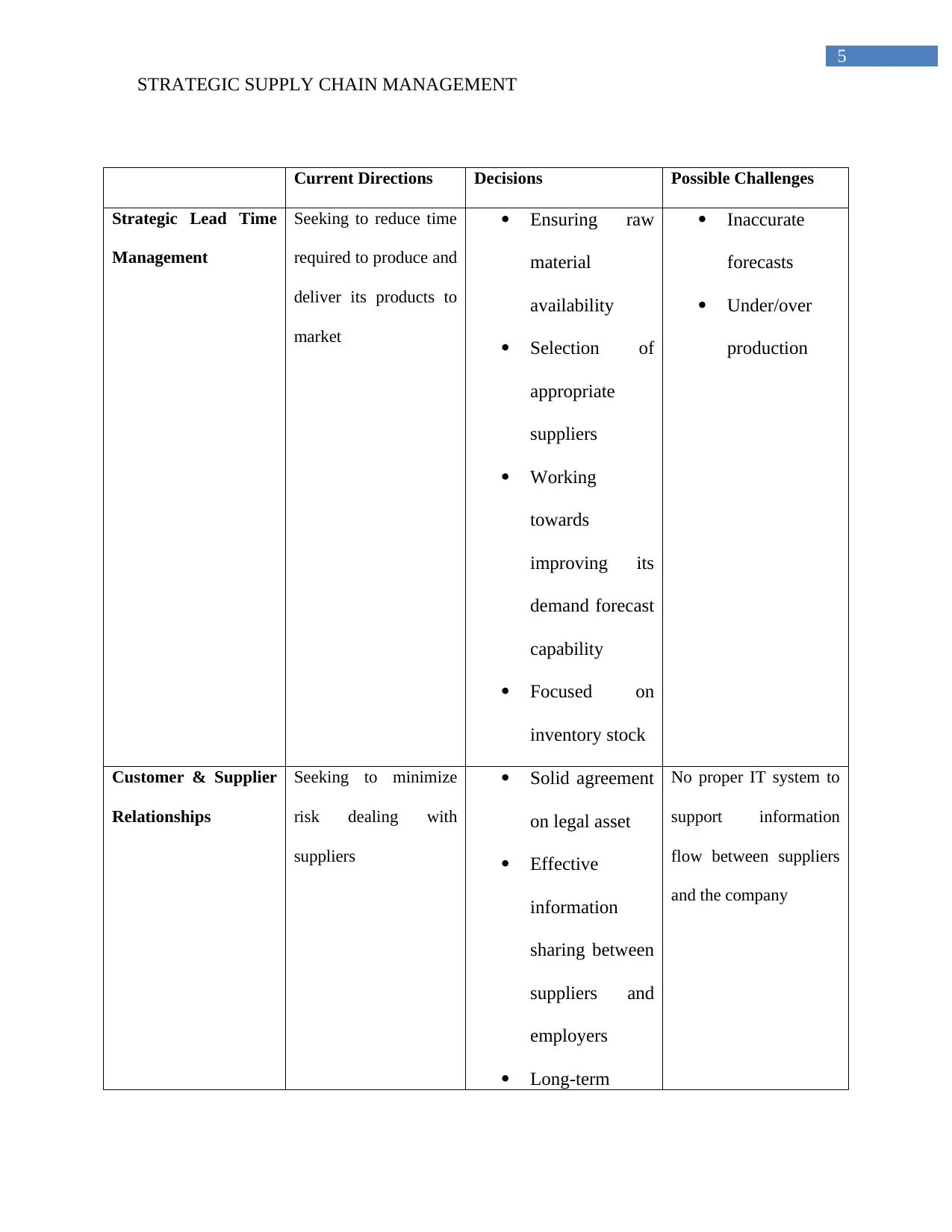
5
STRATEGIC SUPPLY CHAIN MANAGEMENT
Current Directions Decisions Possible Challenges
Strategic Lead Time
Management
Seeking to reduce time
required to produce and
deliver its products to
market
Ensuring raw
material
availability
Selection of
appropriate
suppliers
Working
towards
improving its
demand forecast
capability
Focused on
inventory stock
Inaccurate
forecasts
Under/over
production
Customer & Supplier
Relationships
Seeking to minimize
risk dealing with
suppliers
Solid agreement
on legal asset
Effective
information
sharing between
suppliers and
employers
Long-term
No proper IT system to
support information
flow between suppliers
and the company
STRATEGIC SUPPLY CHAIN MANAGEMENT
Current Directions Decisions Possible Challenges
Strategic Lead Time
Management
Seeking to reduce time
required to produce and
deliver its products to
market
Ensuring raw
material
availability
Selection of
appropriate
suppliers
Working
towards
improving its
demand forecast
capability
Focused on
inventory stock
Inaccurate
forecasts
Under/over
production
Customer & Supplier
Relationships
Seeking to minimize
risk dealing with
suppliers
Solid agreement
on legal asset
Effective
information
sharing between
suppliers and
employers
Long-term
No proper IT system to
support information
flow between suppliers
and the company
⊘ This is a preview!⊘
Do you want full access?
Subscribe today to unlock all pages.

Trusted by 1+ million students worldwide
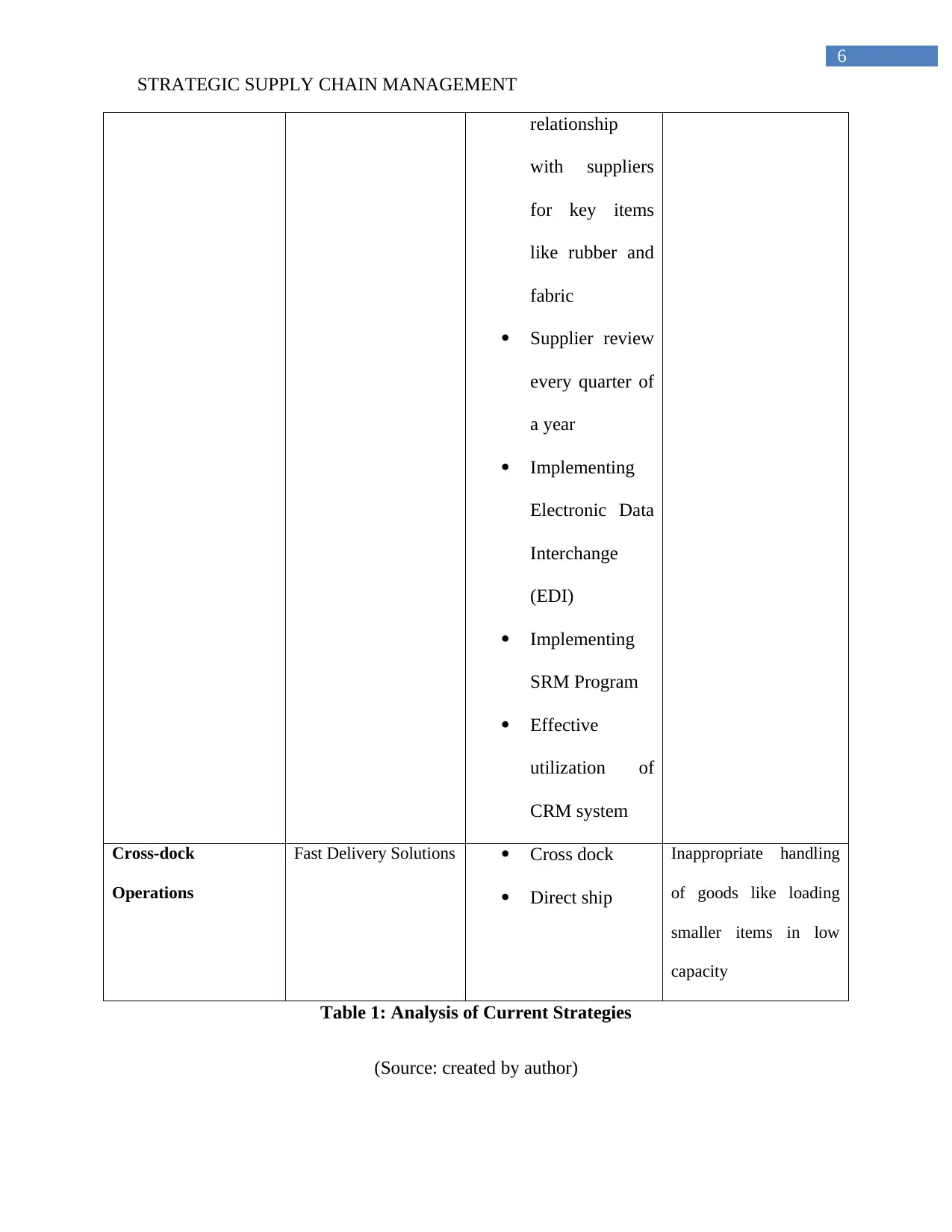
6
STRATEGIC SUPPLY CHAIN MANAGEMENT
relationship
with suppliers
for key items
like rubber and
fabric
Supplier review
every quarter of
a year
Implementing
Electronic Data
Interchange
(EDI)
Implementing
SRM Program
Effective
utilization of
CRM system
Cross-dock
Operations
Fast Delivery Solutions Cross dock
Direct ship
Inappropriate handling
of goods like loading
smaller items in low
capacity
Table 1: Analysis of Current Strategies
(Source: created by author)
STRATEGIC SUPPLY CHAIN MANAGEMENT
relationship
with suppliers
for key items
like rubber and
fabric
Supplier review
every quarter of
a year
Implementing
Electronic Data
Interchange
(EDI)
Implementing
SRM Program
Effective
utilization of
CRM system
Cross-dock
Operations
Fast Delivery Solutions Cross dock
Direct ship
Inappropriate handling
of goods like loading
smaller items in low
capacity
Table 1: Analysis of Current Strategies
(Source: created by author)
Paraphrase This Document
Need a fresh take? Get an instant paraphrase of this document with our AI Paraphraser
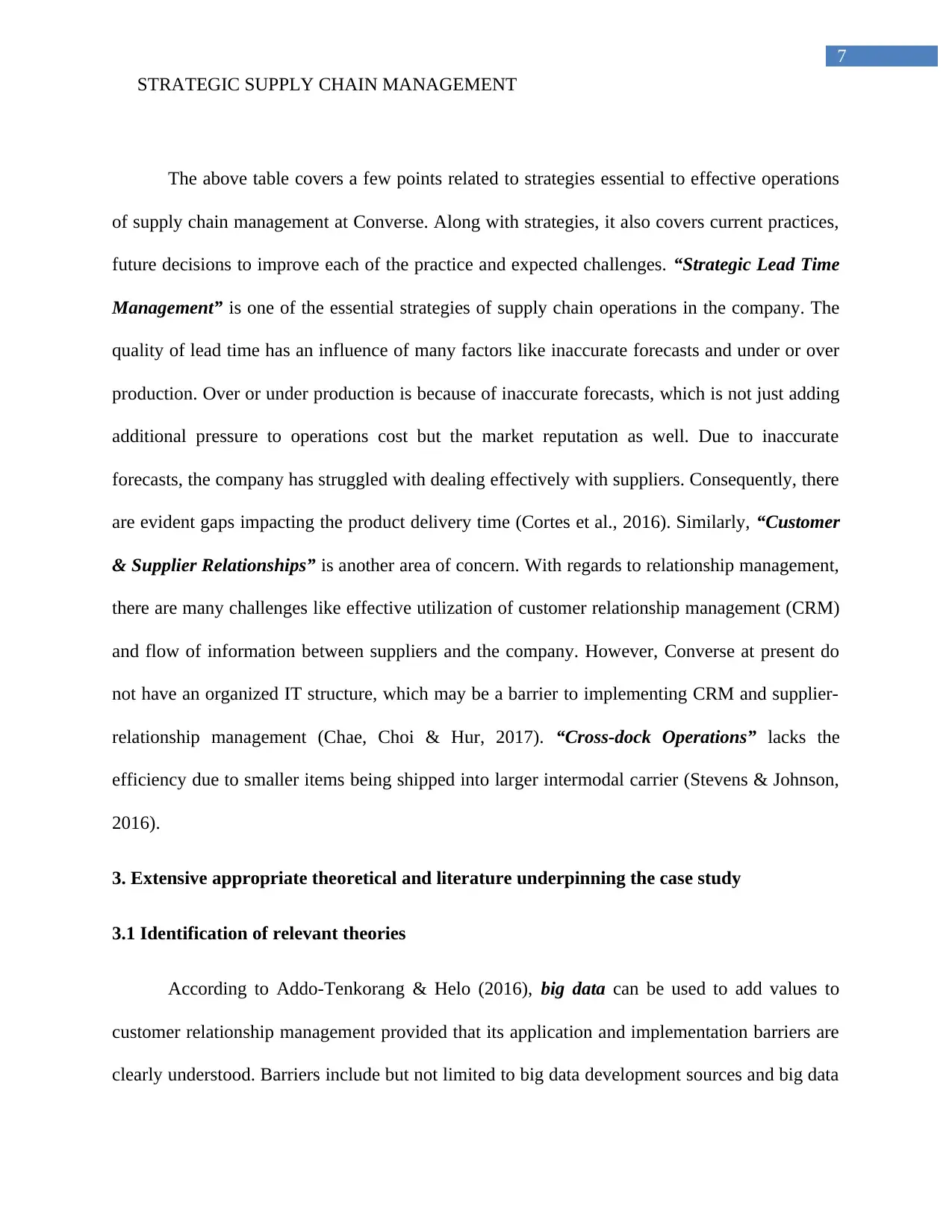
7
STRATEGIC SUPPLY CHAIN MANAGEMENT
The above table covers a few points related to strategies essential to effective operations
of supply chain management at Converse. Along with strategies, it also covers current practices,
future decisions to improve each of the practice and expected challenges. “Strategic Lead Time
Management” is one of the essential strategies of supply chain operations in the company. The
quality of lead time has an influence of many factors like inaccurate forecasts and under or over
production. Over or under production is because of inaccurate forecasts, which is not just adding
additional pressure to operations cost but the market reputation as well. Due to inaccurate
forecasts, the company has struggled with dealing effectively with suppliers. Consequently, there
are evident gaps impacting the product delivery time (Cortes et al., 2016). Similarly, “Customer
& Supplier Relationships” is another area of concern. With regards to relationship management,
there are many challenges like effective utilization of customer relationship management (CRM)
and flow of information between suppliers and the company. However, Converse at present do
not have an organized IT structure, which may be a barrier to implementing CRM and supplier-
relationship management (Chae, Choi & Hur, 2017). “Cross-dock Operations” lacks the
efficiency due to smaller items being shipped into larger intermodal carrier (Stevens & Johnson,
2016).
3. Extensive appropriate theoretical and literature underpinning the case study
3.1 Identification of relevant theories
According to Addo-Tenkorang & Helo (2016), big data can be used to add values to
customer relationship management provided that its application and implementation barriers are
clearly understood. Barriers include but not limited to big data development sources and big data
STRATEGIC SUPPLY CHAIN MANAGEMENT
The above table covers a few points related to strategies essential to effective operations
of supply chain management at Converse. Along with strategies, it also covers current practices,
future decisions to improve each of the practice and expected challenges. “Strategic Lead Time
Management” is one of the essential strategies of supply chain operations in the company. The
quality of lead time has an influence of many factors like inaccurate forecasts and under or over
production. Over or under production is because of inaccurate forecasts, which is not just adding
additional pressure to operations cost but the market reputation as well. Due to inaccurate
forecasts, the company has struggled with dealing effectively with suppliers. Consequently, there
are evident gaps impacting the product delivery time (Cortes et al., 2016). Similarly, “Customer
& Supplier Relationships” is another area of concern. With regards to relationship management,
there are many challenges like effective utilization of customer relationship management (CRM)
and flow of information between suppliers and the company. However, Converse at present do
not have an organized IT structure, which may be a barrier to implementing CRM and supplier-
relationship management (Chae, Choi & Hur, 2017). “Cross-dock Operations” lacks the
efficiency due to smaller items being shipped into larger intermodal carrier (Stevens & Johnson,
2016).
3. Extensive appropriate theoretical and literature underpinning the case study
3.1 Identification of relevant theories
According to Addo-Tenkorang & Helo (2016), big data can be used to add values to
customer relationship management provided that its application and implementation barriers are
clearly understood. Barriers include but not limited to big data development sources and big data

8
STRATEGIC SUPPLY CHAIN MANAGEMENT
analysis. These barriers are hard to be resolved as this requires significant changes at the
different levels in organization. It includes a strategic involvement of managers belonging to
each of the hierarch tiers. Employee engagement is also an important part of such changes. In
addition, identification, procurement and implementation of relevant technologies are also the
associated processes. With regards to Converse, its management team has also identified the
usefulness of collecting and capitalizing the data thus obtained. Hence, the future business plan
of Converse is in the line with the chosen article.
As opined by Kumar & Rahman (2015), an in-depth analysis of the supply chain and its
processes reveals that a buyer-supplier relationship should be determined by looking onto the
capability and capacity of the supplier firm. In cases when the supplier firm lack the requisite
quality or does not also possess the certificate of standard operation; such firms must be assisted
with appropriate solution. The employer firm in this regard can come up with some standard
procedure or can even provide guidance in the form of an informal training. Converse although
have some solid plans to improve supplier-relationship management; it currently does not have
the appropriate IT infrastructure. Hence, the company has a huge task ahead of them.
As observed by Mohammadi & Mohammadi (2016), just-in-time (JIT) approach is a
process to efficiently manage the inventories and reducing the wastage. These two factors are of
vital importance to any major business. If these are not met appropriately this will miserably
affect the efficiency of supply chain operations management and will also elevate the operations
cost. JIT is in direct proportion with demand forecast. It means that to have an effective JIT in
place it is also necessary to be efficient in demand forecast. Demand forecast helps to attain the
integral objective of JIT, which is to produce products when it is only required and also meeting
STRATEGIC SUPPLY CHAIN MANAGEMENT
analysis. These barriers are hard to be resolved as this requires significant changes at the
different levels in organization. It includes a strategic involvement of managers belonging to
each of the hierarch tiers. Employee engagement is also an important part of such changes. In
addition, identification, procurement and implementation of relevant technologies are also the
associated processes. With regards to Converse, its management team has also identified the
usefulness of collecting and capitalizing the data thus obtained. Hence, the future business plan
of Converse is in the line with the chosen article.
As opined by Kumar & Rahman (2015), an in-depth analysis of the supply chain and its
processes reveals that a buyer-supplier relationship should be determined by looking onto the
capability and capacity of the supplier firm. In cases when the supplier firm lack the requisite
quality or does not also possess the certificate of standard operation; such firms must be assisted
with appropriate solution. The employer firm in this regard can come up with some standard
procedure or can even provide guidance in the form of an informal training. Converse although
have some solid plans to improve supplier-relationship management; it currently does not have
the appropriate IT infrastructure. Hence, the company has a huge task ahead of them.
As observed by Mohammadi & Mohammadi (2016), just-in-time (JIT) approach is a
process to efficiently manage the inventories and reducing the wastage. These two factors are of
vital importance to any major business. If these are not met appropriately this will miserably
affect the efficiency of supply chain operations management and will also elevate the operations
cost. JIT is in direct proportion with demand forecast. It means that to have an effective JIT in
place it is also necessary to be efficient in demand forecast. Demand forecast helps to attain the
integral objective of JIT, which is to produce products when it is only required and also meeting
⊘ This is a preview!⊘
Do you want full access?
Subscribe today to unlock all pages.

Trusted by 1+ million students worldwide
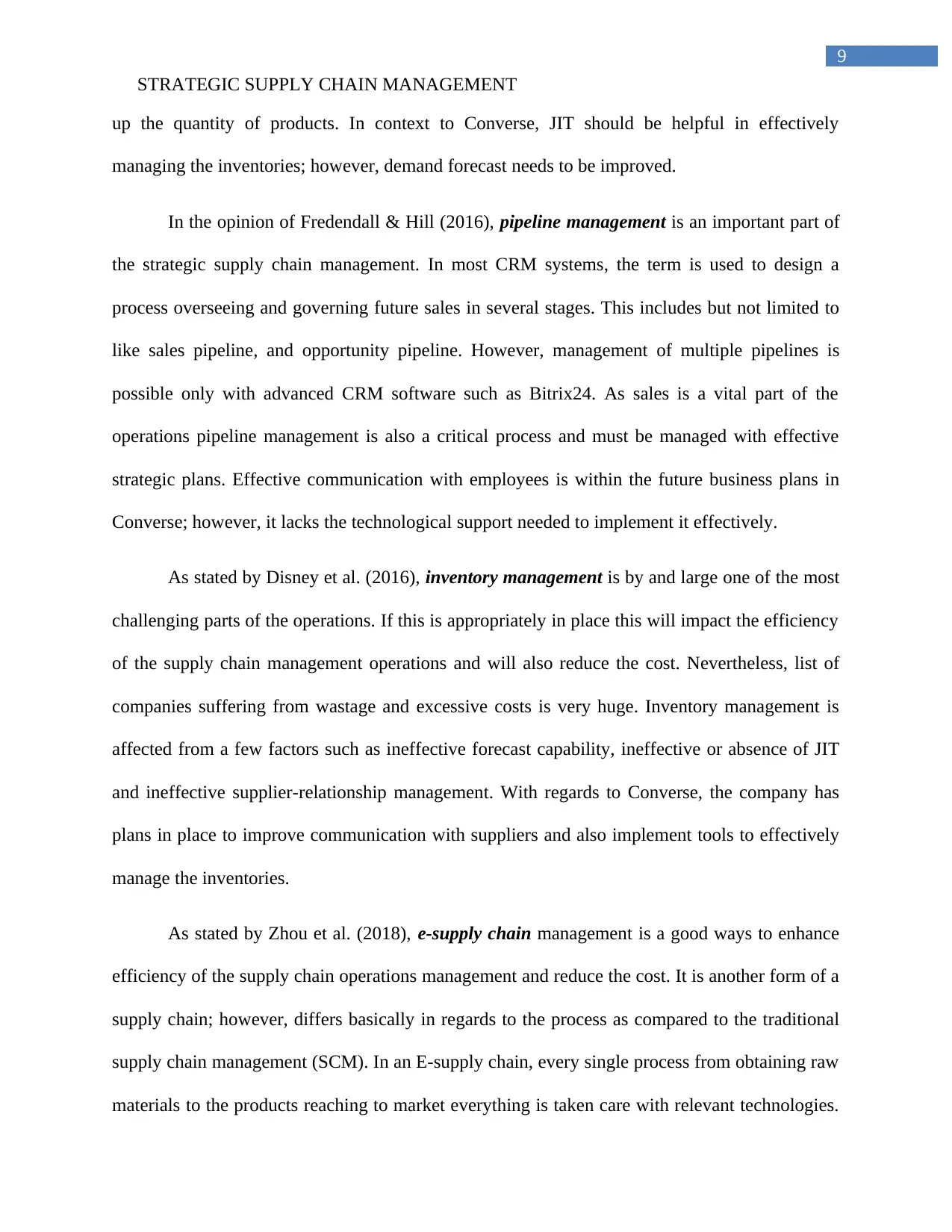
9
STRATEGIC SUPPLY CHAIN MANAGEMENT
up the quantity of products. In context to Converse, JIT should be helpful in effectively
managing the inventories; however, demand forecast needs to be improved.
In the opinion of Fredendall & Hill (2016), pipeline management is an important part of
the strategic supply chain management. In most CRM systems, the term is used to design a
process overseeing and governing future sales in several stages. This includes but not limited to
like sales pipeline, and opportunity pipeline. However, management of multiple pipelines is
possible only with advanced CRM software such as Bitrix24. As sales is a vital part of the
operations pipeline management is also a critical process and must be managed with effective
strategic plans. Effective communication with employees is within the future business plans in
Converse; however, it lacks the technological support needed to implement it effectively.
As stated by Disney et al. (2016), inventory management is by and large one of the most
challenging parts of the operations. If this is appropriately in place this will impact the efficiency
of the supply chain management operations and will also reduce the cost. Nevertheless, list of
companies suffering from wastage and excessive costs is very huge. Inventory management is
affected from a few factors such as ineffective forecast capability, ineffective or absence of JIT
and ineffective supplier-relationship management. With regards to Converse, the company has
plans in place to improve communication with suppliers and also implement tools to effectively
manage the inventories.
As stated by Zhou et al. (2018), e-supply chain management is a good ways to enhance
efficiency of the supply chain operations management and reduce the cost. It is another form of a
supply chain; however, differs basically in regards to the process as compared to the traditional
supply chain management (SCM). In an E-supply chain, every single process from obtaining raw
materials to the products reaching to market everything is taken care with relevant technologies.
STRATEGIC SUPPLY CHAIN MANAGEMENT
up the quantity of products. In context to Converse, JIT should be helpful in effectively
managing the inventories; however, demand forecast needs to be improved.
In the opinion of Fredendall & Hill (2016), pipeline management is an important part of
the strategic supply chain management. In most CRM systems, the term is used to design a
process overseeing and governing future sales in several stages. This includes but not limited to
like sales pipeline, and opportunity pipeline. However, management of multiple pipelines is
possible only with advanced CRM software such as Bitrix24. As sales is a vital part of the
operations pipeline management is also a critical process and must be managed with effective
strategic plans. Effective communication with employees is within the future business plans in
Converse; however, it lacks the technological support needed to implement it effectively.
As stated by Disney et al. (2016), inventory management is by and large one of the most
challenging parts of the operations. If this is appropriately in place this will impact the efficiency
of the supply chain management operations and will also reduce the cost. Nevertheless, list of
companies suffering from wastage and excessive costs is very huge. Inventory management is
affected from a few factors such as ineffective forecast capability, ineffective or absence of JIT
and ineffective supplier-relationship management. With regards to Converse, the company has
plans in place to improve communication with suppliers and also implement tools to effectively
manage the inventories.
As stated by Zhou et al. (2018), e-supply chain management is a good ways to enhance
efficiency of the supply chain operations management and reduce the cost. It is another form of a
supply chain; however, differs basically in regards to the process as compared to the traditional
supply chain management (SCM). In an E-supply chain, every single process from obtaining raw
materials to the products reaching to market everything is taken care with relevant technologies.
Paraphrase This Document
Need a fresh take? Get an instant paraphrase of this document with our AI Paraphraser

10
STRATEGIC SUPPLY CHAIN MANAGEMENT
These technologies contribute to an effective communication between suppliers and the
employer. Converse as evident from the case study description does not seem like have worked
towards implementing an e-SCM. Moreover, the company does not also have a robust IT
infrastructure needed to connect everything in the SCM with suitable technologies.
According to Govindan, Soleimani & Kannan (2015), closed-loop supply chain is
essential to attaining sustainability in supply chain management operations. In this supply chain,
manufacturers do not just own the manufacturing and distribution of products but also to
effectively dispose the residuals. It means firms practicing a closed-loop supply chain are
involved in the process till the very end. They have plans to recollect the sold or waste items.
They take the ownership of such products and implement the take-back programs. The strategic
supply chain management plan for the future does not include the focus on closed-loop supply
chain. Hence, the strategic supply chain management may be able to repair a few damage being
done to the supply operations. However, this may not help in attaining operations sustainability.
Lean manufacturing as according to Sanders, Elangeswaran & Wulfsberg (2016) is a
way to reduce the wastage. This works in accordance with total quality management (TQM).
TQM is a process to implement quality practice at each level of the company (Ross, 2017). Lean
approach is, therefore, a long-term approach to conduct an effective inventory management and
reduce the wastage. Lean manufacturing requires a big change to be applied at each level of
operations like improving employee engagement level. The future business plan at Converse
does not really include strategy for lean manufacturing. Despite being to several inventory
management issues Converse did not really have plans to implement lean manufacturing.
As opined by Borse & Attarde (2016), six-sigma is a process to improve supply chain
operations by repairing and identifying the causes of problems. It does so with the help of its
STRATEGIC SUPPLY CHAIN MANAGEMENT
These technologies contribute to an effective communication between suppliers and the
employer. Converse as evident from the case study description does not seem like have worked
towards implementing an e-SCM. Moreover, the company does not also have a robust IT
infrastructure needed to connect everything in the SCM with suitable technologies.
According to Govindan, Soleimani & Kannan (2015), closed-loop supply chain is
essential to attaining sustainability in supply chain management operations. In this supply chain,
manufacturers do not just own the manufacturing and distribution of products but also to
effectively dispose the residuals. It means firms practicing a closed-loop supply chain are
involved in the process till the very end. They have plans to recollect the sold or waste items.
They take the ownership of such products and implement the take-back programs. The strategic
supply chain management plan for the future does not include the focus on closed-loop supply
chain. Hence, the strategic supply chain management may be able to repair a few damage being
done to the supply operations. However, this may not help in attaining operations sustainability.
Lean manufacturing as according to Sanders, Elangeswaran & Wulfsberg (2016) is a
way to reduce the wastage. This works in accordance with total quality management (TQM).
TQM is a process to implement quality practice at each level of the company (Ross, 2017). Lean
approach is, therefore, a long-term approach to conduct an effective inventory management and
reduce the wastage. Lean manufacturing requires a big change to be applied at each level of
operations like improving employee engagement level. The future business plan at Converse
does not really include strategy for lean manufacturing. Despite being to several inventory
management issues Converse did not really have plans to implement lean manufacturing.
As opined by Borse & Attarde (2016), six-sigma is a process to improve supply chain
operations by repairing and identifying the causes of problems. It does so with the help of its
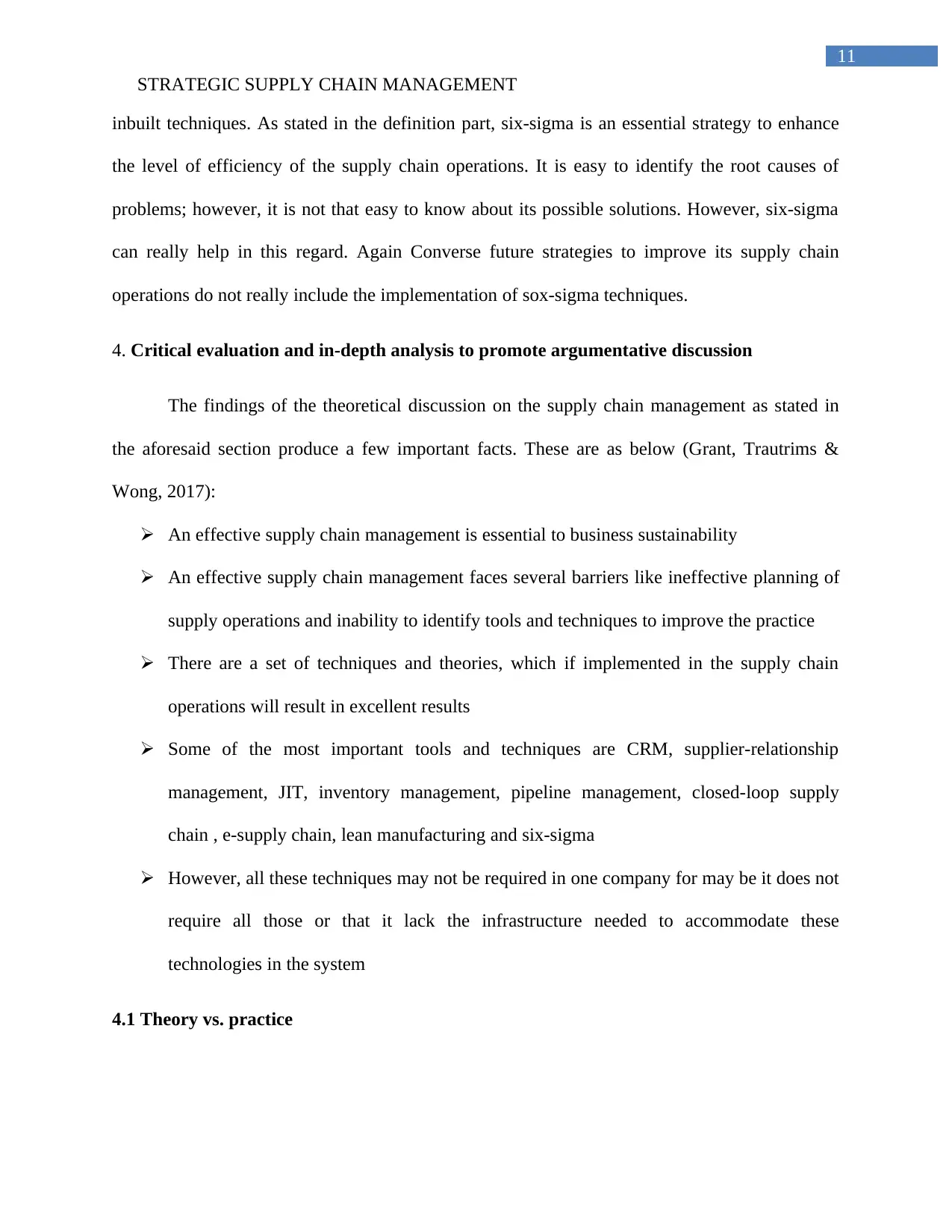
11
STRATEGIC SUPPLY CHAIN MANAGEMENT
inbuilt techniques. As stated in the definition part, six-sigma is an essential strategy to enhance
the level of efficiency of the supply chain operations. It is easy to identify the root causes of
problems; however, it is not that easy to know about its possible solutions. However, six-sigma
can really help in this regard. Again Converse future strategies to improve its supply chain
operations do not really include the implementation of sox-sigma techniques.
4. Critical evaluation and in-depth analysis to promote argumentative discussion
The findings of the theoretical discussion on the supply chain management as stated in
the aforesaid section produce a few important facts. These are as below (Grant, Trautrims &
Wong, 2017):
An effective supply chain management is essential to business sustainability
An effective supply chain management faces several barriers like ineffective planning of
supply operations and inability to identify tools and techniques to improve the practice
There are a set of techniques and theories, which if implemented in the supply chain
operations will result in excellent results
Some of the most important tools and techniques are CRM, supplier-relationship
management, JIT, inventory management, pipeline management, closed-loop supply
chain , e-supply chain, lean manufacturing and six-sigma
However, all these techniques may not be required in one company for may be it does not
require all those or that it lack the infrastructure needed to accommodate these
technologies in the system
4.1 Theory vs. practice
STRATEGIC SUPPLY CHAIN MANAGEMENT
inbuilt techniques. As stated in the definition part, six-sigma is an essential strategy to enhance
the level of efficiency of the supply chain operations. It is easy to identify the root causes of
problems; however, it is not that easy to know about its possible solutions. However, six-sigma
can really help in this regard. Again Converse future strategies to improve its supply chain
operations do not really include the implementation of sox-sigma techniques.
4. Critical evaluation and in-depth analysis to promote argumentative discussion
The findings of the theoretical discussion on the supply chain management as stated in
the aforesaid section produce a few important facts. These are as below (Grant, Trautrims &
Wong, 2017):
An effective supply chain management is essential to business sustainability
An effective supply chain management faces several barriers like ineffective planning of
supply operations and inability to identify tools and techniques to improve the practice
There are a set of techniques and theories, which if implemented in the supply chain
operations will result in excellent results
Some of the most important tools and techniques are CRM, supplier-relationship
management, JIT, inventory management, pipeline management, closed-loop supply
chain , e-supply chain, lean manufacturing and six-sigma
However, all these techniques may not be required in one company for may be it does not
require all those or that it lack the infrastructure needed to accommodate these
technologies in the system
4.1 Theory vs. practice
⊘ This is a preview!⊘
Do you want full access?
Subscribe today to unlock all pages.

Trusted by 1+ million students worldwide
1 out of 20
Related Documents
Your All-in-One AI-Powered Toolkit for Academic Success.
+13062052269
info@desklib.com
Available 24*7 on WhatsApp / Email
![[object Object]](/_next/static/media/star-bottom.7253800d.svg)
Unlock your academic potential
Copyright © 2020–2025 A2Z Services. All Rights Reserved. Developed and managed by ZUCOL.





